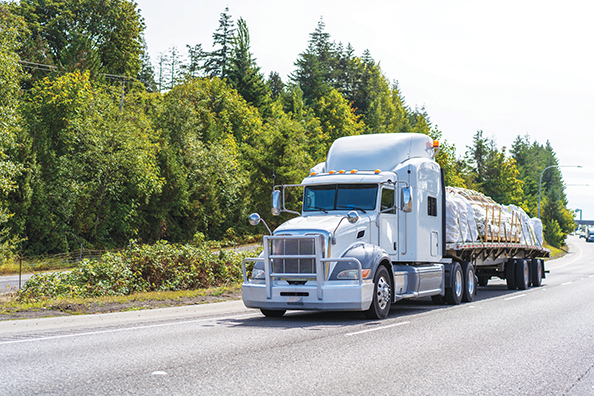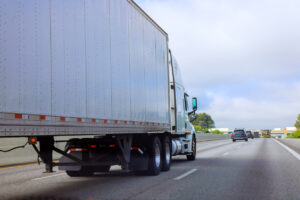Spend some time on any highway that’s frequented by trucks and you’ll soon realize that trailers come in an amazing variety of shapes and styles. The jobs involved in pulling those trailers do, too.
While many drivers prefer to stay with a single type of trailer, others keep their trucking careers fresh and interesting by trying something different. Here are some of the different trailer types and a few tips on what the drivers who pull them experience in their daily work.
Dry van, or “box” trailers, are the most popular. The most common cargo is boxes of product, stacked on pallets or on “slip sheets” and loaded by forklift. Products that are too big for boxing, such as paper rolls, tires or carpet, can be placed as necessary to balance the weight properly.
Some loads fill the trailer and don’t require securing, while smaller loads may require securing. When freight securement is necessary, many trailers are equipped with tracks in the sidewalls where straps can be anchored, helping prevent cargo from shifting during travel. Load locks, adjustable bars or pipes with rubber feet that are held in place by tension, are used in some trailers. Dry vans typically have wood floors so bracing can be nailed down to help minimize shifting.
Even when secured by straps or load bars, some freight can suddenly shift during a hard stop or on a sharp curve. This can cause damage to the cargo or make unloading difficult and — if severe enough — cause the truck to roll over.
Refrigerated trailers, or “reefers,” can help maintain either cold or warm temperatures for cargo. Temperatures can be set as needed to keep products frozen or simply refrigerated. Reefers are often used in winter to provide warmth, preventing sensitive products from freezing.
Because the refrigeration units and the diesel tanks that power them add weight, refrigerated trailers can’t haul quite as much as a typical van trailer. One advantage, however, is that reefers can haul dry freight too, increasing the number of available loads.
Drivers who work with refrigerated trailers are responsible for making sure cargo is kept at the temperature specified by the customer and for keeping enough diesel fuel to run the unit until delivery.
Depending on the cargo, reefers can have a higher center of gravity than some dry vans, requiring caution on turns and curves. Many pickups and deliveries are to grocery warehouses and other locations where wait time can be excessive, and drivers are often called on to handle at least a part of the freight, or to contract with “lumpers” to load or unload.
Flatbed trailers are typically used to transport construction materials, vehicles or anything too large or difficult to load in a van-type trailer. They can be loaded from the rear when backed into a dock, or from either side; flatbed trailers are frequently loaded by overhead crane.
Drivers are responsible for safely securing whatever is loaded on the trailer, following Federal Motor Carrier Safety Regulations (FMCSR). Chains, straps and other methods are used. Heavy items such as steel coils or pipe can be deadly in an accident if not properly secured.
Drivers must protect some cargo from water damage by covering it with a tarp, which must be tightly secured to make sure water can’t get in and to keep the cover from being pulled off or damaged in the vehicle’s wind stream. Securing and tarping cargo can require handling heavy tie-down equipment and climbing on the trailer. Physical strength and agility are important.
Depending on the cargo and customer, loading and unloading can sometimes be quick, and flatbed drivers aren’t often required to handle the cargo itself.
Other types of flatbed trailer include drop deck, double drop and removable gooseneck (RGN), commonly known as a “low boy.” These trailers are often used to haul vehicles or equipment that would be too large to legally transport on a flatbed.
Driving with a flatbed requires constant monitoring for loose chains or straps and blowing tarps. Cargo that is over-dimensional or heavy may require extra permits and, depending on the jurisdiction, can be subject to special rules, such as daylight hours only.
Tank trailers can be easy to load and unload, and there is often no line at the delivery point. Due to the high center of gravity, trailers tend to be top-heavy. Drivers must exercise caution on turns and curves.
Additionally, liquids hauled in tanks can slosh (move from side to side) and surge (end to end), especially when the tank isn’t completely full. Either can exert force on the vehicle and could contribute to a rollover.
Because many tank loads are hazardous materials, some jobs require a Haz-Mat (hazardous materials) endorsement and special rules may apply, such as a prohibition against using tunnels or certain bridges.
Pneumatic tanks are used to haul dry, powdered or granular substances such as sand or popcorn, and baking products such as flour and sugar. A stream of pressurized air carries the product through tubes and hoses into silos or storage containers. These tanks can be dusty and noisy, but they load and unload reasonably quickly.
Pressurized tanks are used for compressed gases such as propane, oxygen and more.
Dump trailers are often used in construction for dirt, gravel and asphalt, but can also haul other dry products such as lime or fertilizer. Many unload through a tailgate but those designed to haul grain often “belly dump” through openings under the trailer. Dump trailers can be very unstable when the box is raised for unloading and can be top-heavy when driving, depending on the cargo. Loading and unloading is usually quick and easy.
Auto haulers are often responsible for loading and unloading vehicles without damaging them. They must be loaded correctly for proper weight distribution, with each vehicle properly secured against movement. Deliveries are sometimes tricky, as the driver may have to park on or next to the highway when unloading.
Livestock haulers must be knowledgeable about the animals they transport and able to ensure the animals’ safety and comfort during the trip. Pickups and deliveries are often in rural areas on roads not designed for tractor-trailers.
Space doesn’t permit a more detailed explanation of each type of trucking, and there are other trailer types not listed here. Many drivers enjoy talking about their craft and will be glad to tell you all about the trucking niche they find most rewarding. All you have to do is ask.
Cliff Abbott is an experienced commercial vehicle driver and owner-operator who still holds a CDL in his home state of Alabama. In nearly 40 years in trucking, he’s been an instructor and trainer and has managed safety and recruiting operations for several carriers. Having never lost his love of the road, Cliff has written a book and hundreds of songs and has been writing for The Trucker for more than a decade.
















I’m glad you mentioned how refrigerated trailers are used to ensure the cargo is kept at the specified storing temperature, so they’re often used by many pickups and deliveries. I imagine if you manage a business that sells tubs of ice creams and provides deliveries for them, it’s best to have a refrigerated trailer to use to keep them from melting. I’ll be sure to keep this in mind if I ever need to store frozen goods for deliveries. https://adamsiscooler.com/